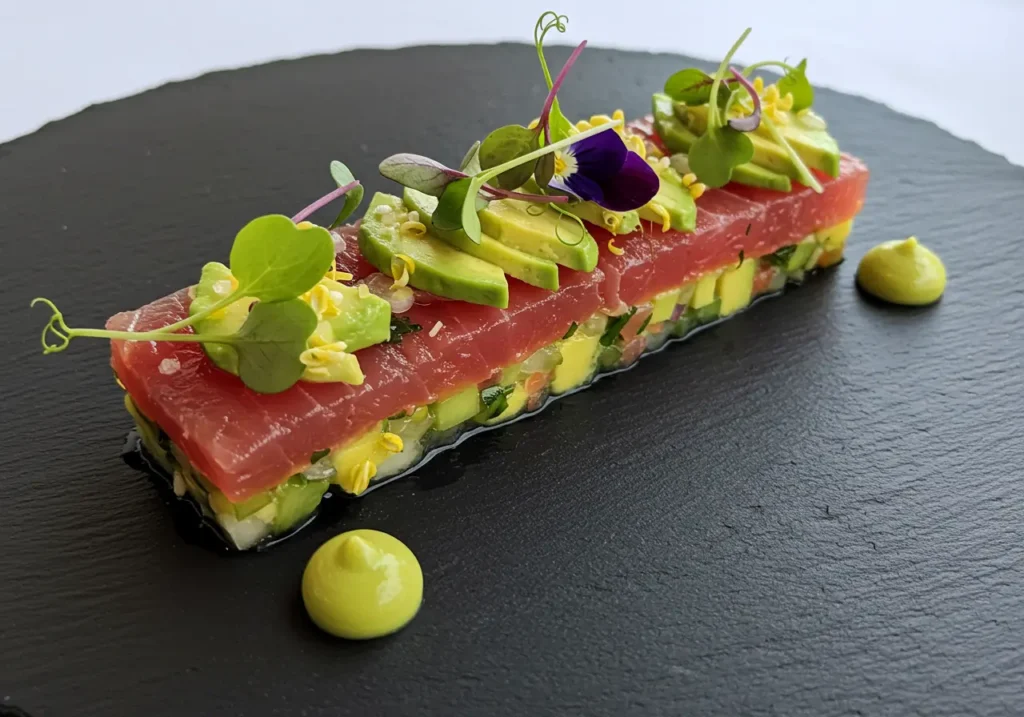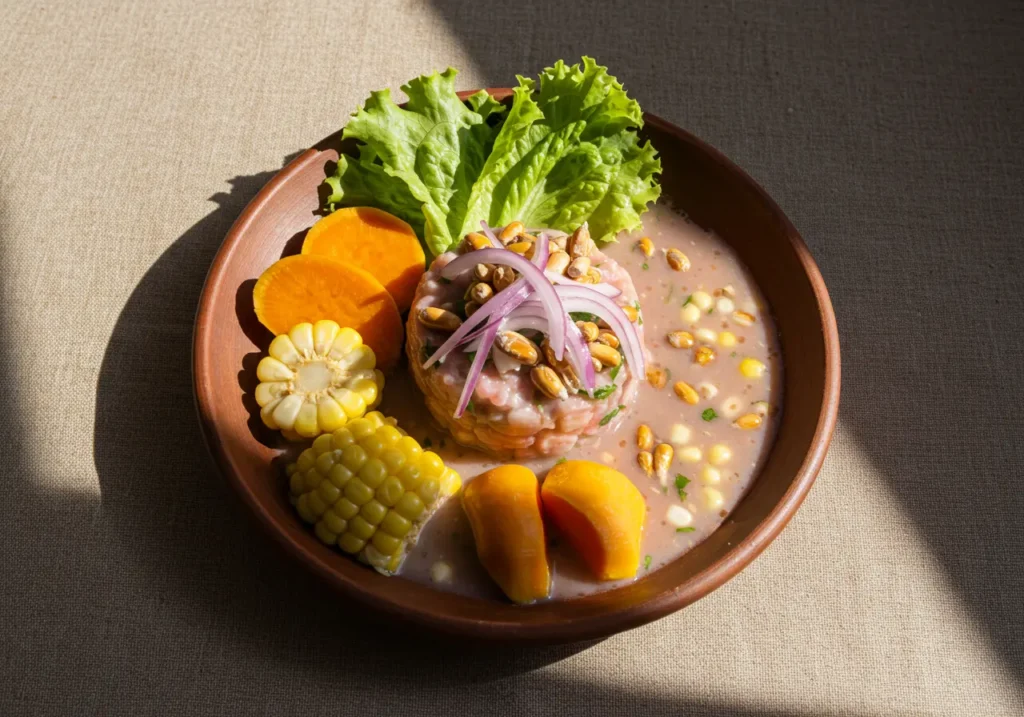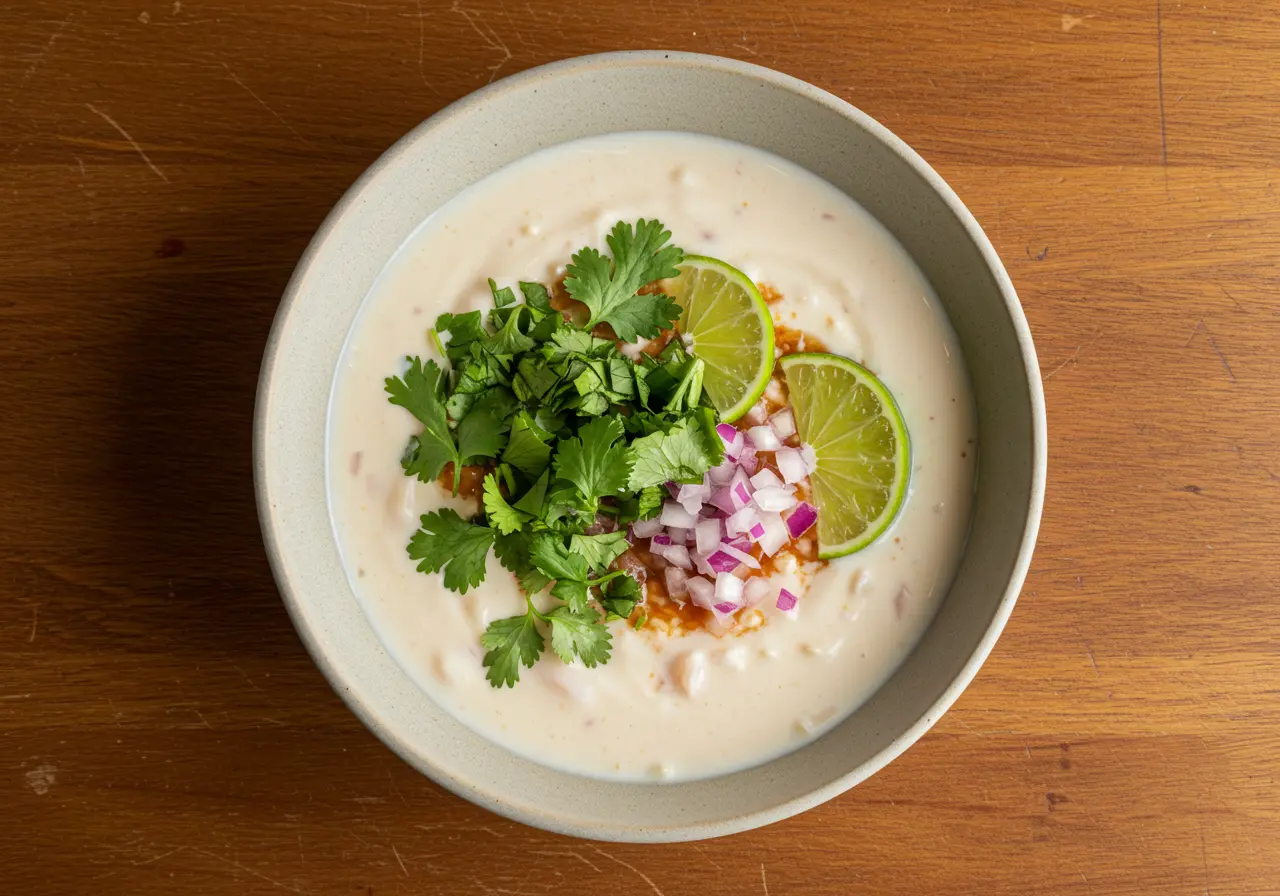Introduction:
If you’ve ever been lucky enough to dive into the flavorful world of Peruvian cuisine, then chances are you’ve encountered the bold, zesty, and wildly invigorating Leche de Tigre. Known in English as Tiger’s Milk, this tangy, citrus-forward mixture is far more than a ceviche marinade—it’s a shot of life, tradition, and culinary flair served in a glass. This guide goes all in: from its cultural roots and mouthwatering ingredients to how I personally prepared it in my own kitchen (spoiler alert: it blew my taste buds away!).
We’ll travel through authentic methods, explore its nutritional perks, taste local variations, and even troubleshoot common mistakes. Whether you’re a foodie curious about global flavors, a home cook wanting to up your seafood game, or just someone looking for a leche de tigre recipe that actually works—this deep dive is your new kitchen bible.
Part 1: Introduction to Leche de Tigre
What is Leche de Tigre?
Let’s cut to the chase—Leche de Tigre is not your average dish. It’s the vibrant, spicy, and slightly creamy citrus marinade used in traditional Peruvian ceviche. But guess what? In Peru, they don’t just toss it aside after the fish soaks up its magic. Nope. They drink it. Straight up.
Now, don’t be put off by the name. No tigers were harmed in the making of this magical potion. The term Tiger’s Milk symbolizes strength and vitality, and it’s believed to have powerful energizing properties. Some say it’s a hangover cure, others swear it’s an aphrodisiac. Either way, this liquid gold is loaded with flavor—thanks to ingredients like lime juice, onions, aji amarillo, cilantro stems, ginger, and the juices released by fresh raw fish.
It can be served as a cold shooter, a starter in fine dining, or the star of a dish on its own. And once you’ve tasted it, it’s hard to forget.
Personal Experience with Leche de Tigre
The first time I tried Leche de Tigre, I was standing in a bustling market stall in Lima. It was served in a shot glass, accompanied by toasted cancha and sweet potato. My first reaction? Surprise. It was sharp, zesty, and oh-so-spicy. The lime hit first, followed by the slight brininess of the fish stock, and then the heat of the ají snuck in like a stealthy sidekick. I felt like I had just been woken up from a flavor nap.
Inspired, I decided to recreate the dish at home. With a bit of research (and some failed attempts—too salty, too sour, too thin), I finally found a balance. Making Leche de Tigre isn’t complicated, but it does demand respect. The freshness of your ingredients is key, and your blender becomes your best friend. It’s one of those dishes where every tweak makes a difference, and you’ll feel like a chef and a chemist at once.
Part 2: The Origins and Evolution of Leche de Tigre
Ancient Beginnings of Leche de Tigre
Way before Leche de Tigre became the stylish shooter served in fine dining circles, its roots were firmly planted in the daily lives of indigenous Peruvian civilizations. Back then, before citrus fruits like lime ever made their juicy debut, the ancestors used a completely different kind of acid to preserve fish—fermented chicha de jora (a corn-based beverage) and local fruit juices were the real MVPs.
These early forms of ceviche were far from what we’d recognize today. There were no fiery ají peppers, no red onions adding crunch, and certainly no lime juice to balance the tang. And yet, these ancient chefs understood something essential—acid tenderizes fish and intensifies flavor. They may not have had our modern palate, but they sure knew how to throw down in the kitchen with what nature gave them.
Peru’s coastal regions, rich in marine bounty, became the testing ground for this culinary ingenuity. Fish was plentiful, preservation was essential, and creativity thrived. The absence of citrus didn’t limit them—it just paved the way for innovation. And as you’ll soon see, things were just getting started.
Spanish Influence on Leche de Tigre’s Recipe
Now, fast forward to the 16th century. The Spanish arrived and brought their pantry with them—limes, onions, and garlic being the most game-changing imports. The moment lime met fish, it was a match made in culinary heaven. No more waiting hours for fermentation—now the acid from limes could “cook” fish in mere minutes. Boom. The ceviche as we now know it began taking form.
What’s more, onions and garlic didn’t just add flavor. They introduced that essential aromatic backbone to Leche de Tigre. With these new additions, the indigenous recipe evolved into something that straddled two worlds—local wisdom with European flair.
It’s wild to think how a colonization event, while devastating in so many aspects, contributed a twist to a dish that would later become one of Peru’s most iconic creations. Culinary fusion was born, and Leche de Tigre stood proudly at the crossroads.
Modern Refinements in the Leche de Tigre Recipe
By the 20th century, Peruvian chefs weren’t just refining this dish—they were elevating it. No longer just a byproduct of ceviche, Leche de Tigre was front and center on the menu. Bold chefs like Gastón Acurio and Jose Garces began showcasing it in innovative ways—adding shellfish stock, emulsifying it into creamy textures, and even presenting it as a palate cleanser between courses.
Then came the global stage. Peruvian restaurants popped up in Tokyo, New York, London—and everywhere, Leche de Tigre followed. Foodies marveled at its zing, mixologists spun it into cocktails, and street vendors poured it by the glass. It went from a humble fish marinade to an international sensation.
And here’s the kicker—it never lost its soul. Even with all the bells and whistles, the heart of Leche de Tigre is still in that punch of citrus, the bite of onion, and the ocean-kissed savor of fresh fish.
Part 3: Leche de Tigre in Peruvian Culture
Aphrodisiac and Hangover Cure: Myths, Magic & Mornings After
In Peru, Leche de Tigre isn’t just food—it’s practically folklore. Locals often joke, with a wink and a nod, that this citrusy elixir can “revive the dead.” And no, they’re not entirely kidding. Beyond its flavor, Leche de Tigre is widely embraced as a natural hangover remedy and even an aphrodisiac.
On the streets of Lima, you’ll find vendors serving it in shot glasses, sometimes with a spicy kick strong enough to clear your sinuses and reset your entire system. The secret? Its vibrant acidity, essential minerals from seafood, and a splash of heat from ají limo or ají amarillo. It’s a liquid wake-up call—and if you’ve ever had a pisco-fueled night, it might just be your best friend the next day.
Meanwhile, urban legends swirl about its ability to stir more than just your appetite. Some locals genuinely believe it sparks vitality in more… romantic ways. Whether that’s superstition or science, we’ll leave up to your next date night.
A Culinary Staple Across Peru
Beyond the myths and recovery tales, Leche de Tigre is a beloved culinary institution. Stroll through any cevichería—those sacred temples of seafood—and you’ll spot it right at the top of the menu. It might be served as a side to ceviche clásico, poured over sliced fish, or even served solo in a chilled glass, garnished with slivers of red onion and chopped cilantro.
Interestingly, the recipe dances to a different tune depending on where you are in the country. In the north, you’ll find it thicker and more intense, thanks to the use of richer fish and seafood stock. Down south, it’s often lighter, more citrus-forward, and clean on the palate.
These regional twists only enhance its appeal, making it more than just a recipe—it’s a national symbol. Wherever you go in Peru, Leche de Tigre feels both familiar and refreshingly unique.
Even home gourmet shops like Monadnock Oil and Vinegar are spreading its flavor far beyond South America—bringing Peruvian culture to curious kitchens everywhere.
Part 4: Essential Ingredients and Their Roles
Core Components of an Authentic Leche de Tigre Recipe
Every great Leche de Tigre recipe begins with a handful of vibrant, zesty, and bold ingredients. These aren’t just flavorings—they’re the heartbeat of the dish, working in harmony to create that unmistakable kick.
Let’s start with the lime juice. This one’s non-negotiable. The acidity of freshly squeezed lime acts as the magical agent that “cooks” the fish without heat. It’s not just about sourness—lime juice brings brightness, balance, and an electric kind of freshness that defines the dish.

Then, you’ve got fish stock or freshly pressed seafood juice. This is where the umami lives. It deepens the flavor, gives the base a creamy body, and helps mellow out the intense citrus. The best versions I’ve tried used the leftover juices from ceviche—rich with the essence of fish and vegetables.
Don’t forget the star itself: fresh fish. Thinly sliced or roughly chopped, it adds substance and soul to the mix. Think white-fleshed fish like flounder, corvina, or sea bass. Their neutral flavor lets the other ingredients sing without overpowering the mix.
Now here comes the fire—ají amarillo. This Peruvian yellow chili is a game-changer. It lends a subtle sweetness followed by a mellow, fruity heat. Forget jalapeños—ají amarillo is where the real flavor fiesta begins.
Aromatic and Flavor-Enhancing Extras
Beyond the basics, it’s the extra notes that round out the tune. A clove of garlic gives it depth; a nub of ginger adds that warming zing. Cilantro stems, often tossed aside, pack a concentrated herbal punch that freshens every sip.
A small stalk of celery—yes, celery—adds a whisper of bitterness and body, balancing the sweetness and citrus. Meanwhile, thinly sliced red onions sharpen the flavor and give a satisfying crunch if you leave them in the final pour.
These ingredients, combined just right, create a multi-dimensional taste experience. It’s sour, spicy, salty, and umami all at once. Each sip or bite feels layered and alive, as if every component is chiming in with its own voice.
Curious about how ají amarillo compares to other global chilis? Fine Dining Lovers dives into its sweet heat and why it’s a must-have in any Peruvian dish.
Part 5: Nutritional Insights of Leche de Tigre
Caloric Content: A Low-Calorie Flavor Bomb
When it comes to indulgent flavor with minimal guilt, Leche de Tigre checks all the boxes. Packed with zesty citrus and lean seafood, this Peruvian powerhouse is surprisingly light in calories. A typical ½-cup serving clocks in at just around 60–100 calories, depending on the ingredients and portion of fish or seafood juice used.
What’s incredible is how much taste you get in each sip without piling on fats or carbs. That makes it a standout among other globally popular starters. Compare it to creamy clam chowder or oily tapas spreads, and Leche de Tigre is basically the superhero of light, nutrient-dense cuisine.
So if you’re watching your intake but still want something exciting on your plate—or in your glass—this one’s got your back.
Macronutrient Breakdown: Fueling the Body, Not Weighing It Down
Now, let’s get a little nerdy for a second. Nutritionally speaking, Leche de Tigre is a goldmine of lean protein, especially if it includes shredded or pureed fish. That gives it muscle-building power without the heaviness of saturated fats.
It’s also extremely low in carbs—unless you add sweet potato on the side—and the fats that do appear are usually the omega-3s from fish, which we all know are brain-boosting, heart-loving fats. As for micronutrients? We’re talking about a vitamin-rich broth, with hits of Vitamin C from lime, potassium from celery, and anti-inflammatory properties from ginger and garlic.

Health Considerations: The Raw Fish Dilemma
One word of caution: because this dish uses raw fish, sourcing matters—a lot. You’ll want sushi-grade or ultra-fresh fish from a trusted provider to avoid any unwelcome surprises. The acid in lime juice denatures proteins and kills some bacteria, but it’s not a full-on substitute for heat-based cooking.
If you’re pregnant, immunocompromised, or have seafood allergies, it’s best to consult your doc before indulging. But for most folks? It’s a delicious, nutritious way to recharge and feel good doing it.
Fun fact: Andean Travel Experience reports that some street vendors even promote Leche de Tigre as a post-workout drink. Now that’s what we call functional food.
Part 6: Step-by-Step Leche de Tigre Recipe
Ingredients List: What You’ll Need for the Magic
Ready to make your own bold and bright Leche de Tigre recipe at home? Great! Below is a tested-and-tweaked ingredient list based on traditional Peruvian sources—and yes, some creative liberties I picked up from my own kitchen experiments too.
Ingredients (Serves 2–3 small servings or shooters):
- 1 cup fresh white fish (like sea bass, flounder, or tilapia), chopped
- ½ cup lime juice (from 5–6 fresh limes)
- ¼ cup fish stock or shrimp juice (or cold water in a pinch)
- ¼ red onion, thinly sliced
- 1 small ají amarillo (or substitute with yellow chili or habanero for heat)
- 1 small garlic clove
- 1 tsp grated fresh ginger
- 1 tbsp chopped cilantro stems
- ¼ stalk of celery
- Salt to taste
- Optional: pinch of white pepper, a cube of ice for chilling and emulsifying
🔄 Substitutions: If you can’t find ají amarillo, mix a little bell pepper (for color) with a touch of fresh chili. Don’t skip the cilantro stems—they pack more flavor than the leaves!
Preparation Steps: Blending Boldness with Balance
Marinating the Fish
Start by placing your chopped raw fish in a bowl with the red onion, salt, and lime juice. Let it sit for about 5–10 minutes. This gives the lime juice time to partially “cook” the fish and mellow the onions—a key flavor foundation.
Blending the Marinade
Transfer everything—fish, lime juice, onion, and all—into a blender. Add your fish stock, ají amarillo, garlic, ginger, celery, cilantro stems, and that optional ice cube. Blend until smooth. Not gritty, not watery—you’re aiming for a creamy, velvety consistency.
Straining and Serving Suggestions
Use a fine mesh strainer to pour the liquid into a clean bowl or pitcher. This step is crucial to remove fibrous bits and achieve that classic, silky finish.
To serve: Pour into shot glasses or small bowls. Garnish with extra onion slivers and chopped cilantro. You can even pair it with sweet potato slices or crunchy cancha (toasted corn). It’s a dish that’s both a drink and an experience!
Personal Preparation Experience: From Curiosity to Culinary Joy
My first attempt? Total chaos. I underestimated the lime juice—way too sour—and used fish that wasn’t sushi-grade. But practice makes perfect.
What I learned:
- Balance is key: Too much lime will overpower everything.
- Use ice while blending: It chills and emulsifies the broth beautifully.
- Fresh is non-negotiable: The fresher the fish, the smoother the flavor.
And honestly, when I nailed it on the third try, it felt like I’d unlocked a little piece of Peruvian culinary magic. Totally worth the effort!
Inspired by renowned chefs? This recipe breakdown from Jose Garces highlights the chef’s spin on this classic and offers even more garnish ideas!

Part 7: Creative Twists on Traditional Leche de Tigre
Regional Variations: Peru’s Flavor Map in a Glass
It’s no surprise that a country as ecologically diverse as Peru would have multiple renditions of Leche de Tigre. From the foggy coasts of Lima to the lush jungles of the Amazon, the ingredients and methods shift just enough to offer a whole new experience—while staying rooted in tradition.
In northern Peru, the Leche de Tigre recipe tends to be thicker and creamier. Cevicherías here often toss in a bit of blended fish or shellfish to enrich the broth. It’s hearty, punchy, and sometimes even spicy enough to make you break a sweat.
Down south, in places like Arequipa, it’s all about that clean citrus hit. The preparation is lighter, sometimes with subtle touches of rocoto (a native chili) or orange juice added for balance. The jungle regions may add exotic fruits or river fish, reflecting the abundance of the rainforest.
And in Lima? That’s where the classic, balanced version reigns—a harmonious blend of acid, heat, and umami.
Each twist tells a story. Local markets influence what goes into the blender, and family traditions dictate how it’s served. In that sense, every regional variation is both a recipe and a memory.
Modern Interpretations: Fusion and Culinary Creativity
In recent years, chefs around the globe have spun Leche de Tigre into a playground for innovation.
Some restaurants infuse it with Asian ingredients like miso, yuzu, or even lemongrass—giving birth to Nikkei-style leche de tigre, a fusion of Japanese and Peruvian flavors that’s incredibly elegant. Others turn it into cold seafood shooters, pairing it with shrimp, scallops, or even sea urchin for that luxury edge.
It’s also become a base for creative appetizers—think leche de tigre poured over grilled octopus or even drizzled on avocado toast (yep, that happened in Brooklyn). More playful chefs are incorporating it into ceviche-inspired cocktails, offering it as a shot served with a chili-lime rim.
For a deeper dive into how this evolution reflects Peru’s dynamic culinary identity, check out this fascinating resource at LimaEasy.
One thing’s for sure: Leche de Tigre recipe isn’t just surviving—it’s thriving, reinventing itself with every new plate it touches.
Part 8: How to Serve and Enjoy Leche de Tigre
Traditional Accompaniments: The Classics That Complete the Experience
In Peru, Leche de Tigre is never a solo act. It comes with flavorful, contrasting sides that not only elevate the dish but also help temper its bright, spicy acidity. When I made it at home, I quickly realized that these humble yet brilliant additions make all the difference.
First on the plate: boiled corn, or choclo. With its large, starchy kernels, this native corn is mildly sweet and balances the tang of the citrus beautifully. Next up is sliced sweet potato, soft and earthy, often cut into thick wedges or medallions.
Don’t overlook the lettuce leaves, either. While they may seem decorative, they add a crisp, cooling bite that refreshes your palate after every zingy spoonful of tiger’s milk.
And then there’s cancha—crunchy, toasted corn nuts that are practically mandatory. These nutty, golden nuggets offer just the right texture contrast and a salty counterpoint to the sour-spicy broth. Sprinkle them on top or munch them between sips; either way, they’re pure magic.
Honestly, once you’ve tried the full Leche de Tigre experience, you’ll understand why it’s so much more than just a “starter.”
Beverage Pairings: What to Sip While You Slurp
Finding the right drink to go with Leche de Tigre recipe isn’t just about taste—it’s about balance. The bold acidity and chili heat crave refreshment.
Non-alcoholic choices like chilled coconut water, sparkling citrus water, or even cucumber-mint coolers work wonderfully. They cleanse the palate and cool the burn without clashing.
For those who enjoy a mild fermented fizz, a light, unfiltered kombucha can pair beautifully with the dish’s tang and spice. And although traditionalists might opt for local pairings, I found iced herbal teas—especially ginger or lemongrass—to be unexpectedly perfect.
Curious how Peruvians balance fiery ceviche flavors? Andean Travel Experience explores traditional accompaniments in street food culture and beyond.

